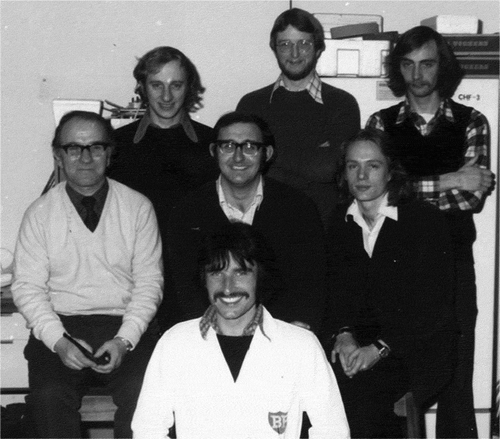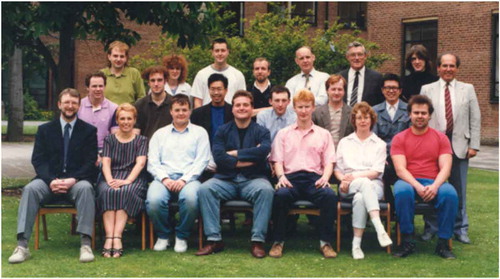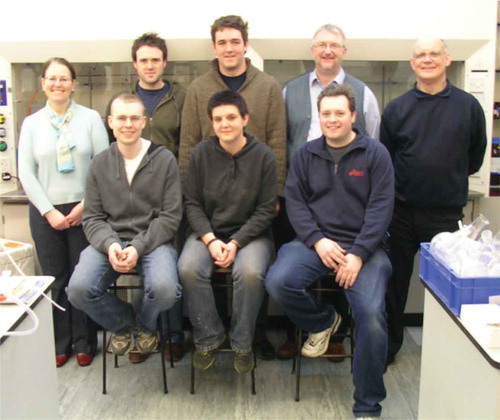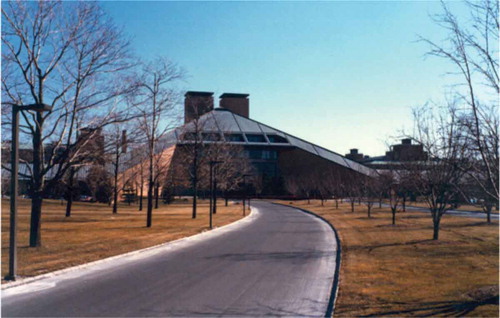This Festschrift is dedicated to Professor John William Goodby FRS on the occasion of his 65th birthday and to reflect upon his career in Liquid Crystals following his retirement. The contributions to this issue represent work and collaborations from John’s many colleagues and friends within the global liquid crystal community. The Festschrift was conceived on the back of a meeting held at the University of York entitled ‘A life in Liquid Crystals’ on 22 September 2016 with the financial support of Kingston Chemicals, Merck and the British Liquid Crystal Society.
To highlight John’s contributions to the field of liquid crystals, it is important first to put his career into context. John graduated in chemistry from Hull University in 1974 and joined Professor George Gray FRS to study for a PhD (see ). During this time, John carried out research on smectic liquid crystals, which led to their classification and nomenclature that is in use today. Much of his early investigations focused on phases that were to become the tilted hexatic B, I and F smectics, and the crystal B, E and H phases. He obtained his PhD in 1977 with a thesis simply entitled ‘Smectic Liquid Crystals’.
Figure 1. George Gray’s early research group. Back row from left: Alan Mosley, John Goodby, Mike Hannant; Middle row from left: George Gray, David Coates, Stephen Kelly; Front row Damien McDonnell.

After a short post-doctoral post in Hull, in 1979, John received the opportunity to join the world-renowned AT&T Bell Laboratories at Murray Hill in NJ, USA (). This proved to be a productive time for John and he was able to collaborate with many outstanding scientists such as Patricia Cladis, Jay Patel and Ron Pindak, to name a few. Some of the most notable work during this stage of his career led to the structural distinction of two types of B phase, namely the hexatic B and the crystal B phase, some early work on low-temperature ferroelectric liquid crystals and defining the relationship between direction of spontaneous polarisation and the spatial configuration of the chiral centre (R or S) and its parity with respect to the position of the stereogenic centre to the core (odd or even atoms), understanding the alignment of smectic liquid crystals and most significantly the experimental discovery of the twist grain boundary phase (TGBA), which is a liquid crystalline analogue of type II superconductors. Already at this stage of his career, John was recognised as a leading scientist in liquid crystals and he progressed from a Member of the Technical Staff to become Supervisor of the Device Materials Research Department at Bell Labs. Many friends and colleagues will have heard one of John’s stories from his time at Bell Labs at some point showing that it played an important role during his career.
In 1988, John was awarded a DSc from Hull University with a thesis entitled ‘The physical and chemical properties of ordered fluids’. At this stage, he also returned to the UK and Hull University, and in 1990, he became the head of the world-renowned Liquid Crystals and Advanced Materials Research Group (see for John’s first research team). Work continued in Hull for the large part with the support of Defence and Evaluation Research Agency (DERA), which later became QinetiQ. The work during this time demonstrated that John’s interests were not restricted to single aspects of liquid crystals but were rich and broad. Indeed, work at Hull saw the development of discotic nematic liquid crystals (which are now used in optical film applications), and the synthesis of difluoro and trifluoroterphenyls (negative Δε nematics) for vertically aligned nematic devices and for use in ferroelectric switching applications. In each of these bodies of work, John always insisted on being able to understand a structure property correlation so that new materials could be designed with better understanding of how to optimise a given property. John also had a strong interest in biological materials, particularly sugar-based liquid crystals and he established strong links to the carbohydrate chemists in France (with visiting positions at the University of Picardie, Amiens and University of Artois), and with strong links to groups in Rennes and INSA-Lyon. Once again, the desire to understand how the structure controlled properties was prevalent.
Figure 3. (colour online) Liquid Crystals and Advanced Materials Research Group, Hull University (1990). Back row from the left: Peter Styring, Maxine Tyler, Neil Thompson, Andy McRoberts, Alan Hall, Ken Toyne and Simon Holder; Middle row from left: Michael Hird, Russell Lewthwaite, Mike Lee, Ellis Bolton, Robert Lewis, Chuchuan Dong and David Lacey; Front row from left: John Goodby, Marlene Clark, Phil Smith, Dave Beattie, Chris Booth, Julie Haley and Andy Slaney.

In 2005, John was appointed as Chair of Materials Chemistry at the University of York and was accompanied by a small research team for this new adventure (). The research continued to go from strength to strength and the research group increased in size (). At this stage, research was across an even broader range of interests and research focused on materials for use as adhesives, gels for use as phantoms for radiation treatment of cancer, smectic liquid crystals for liquid crystal on silicon (LCOS) applications, polymeric liquid crystals for optical film applications, bent core liquid crystals, dendritic liquid crystals, sugar-based liquid crystals and liquid-crystalline coated nanoparticles to highlight just a few of the areas of interest. Despite taking retirement in 2016, John remains a fully active member of the liquid crystal community and continues to pursue interests in research having been appointed to an Emeritus Professorship at the University of York (2016).
Figure 4. (colour online) Liquid Crystal Group at the University of York (January 2005). Back row from the left: Isabel Saez, Mark Godber, Andrew Wilson, John Goodby and Alan Hall; Front row from left: Paul Watson, Verena Görtz and Stephen Cowling.

Figure 5. (colour online) Research group at the University of York (2011). From the left: Paul Reiss, David Stewart, Xiang Jia, Tiantian Ma, Charles Bradbury, Wen Cai, Colin Ellis, John Goodby, Richard Mandle, Verena Görtz, Edward Davies, Duncan Bruce, Charlie Wand, Emily Bevis, Katrina Bakker, Peter Raynes and Isabel Saez.

John’s career has been recognised with many awards, which include the GW Gray Medal of the British Liquid Crystal Society (John was the first recipient of this medal back in 1996), the Tilden Lectureship (2002) and Derek Birchall Medal (2013) of the Royal Society of Chemistry. His research was also recognised as the first recipient of the Luckhurst-Samulski Prize (2009) for the best publication in Liquid Crystals entitled ‘Molecular complexity and the control of self-organising processes’. John’s interdisciplinary interests have also been recognised with the Interdisciplinary Award of the RSC, and more recently the AkzoNobel UK Science Prize (2014). Probably, the most significant recognition for John came in 2011 when he was elected as a Fellow of the Royal Society. He subsequently was awarded with The Royal Medal of the Royal Society for his major advances and discoveries of new forms of matter and materials in 2016. Previous recipients of The Royal Medal include Dirac, Perutz, Barton, Crick and Hilsum.
Anyone who has worked with John will realise that he has contributed massively to the Liquid Crystal community, not just through his scientific contributions, but from a leadership role too, chairing both the British Liquid Crystal Society (2003–2005) and the International Liquid Crystal Society (2000–2004, Honored Member 2010). He is passionate about science and colleagues that have worked with him know how his enthusiasm and wealth of knowledge can drive a project forward. The meeting in York to reflect on John’s retirement was a way of feeding back to John the respect and fondness that he holds within the community. This meeting was fascinating from a scientific point of view and contained contributions from young and senior scientists alike. Young scientists such as Richard Mandle, Craig Archbald and Mark Sims gave presentations on their current research under the guidance of John (myself and John Moore) whereas there were contributions from Jagdish Vij (Ferroelectrics), Helen Gleeson (Bent core), Isabel Saez (Dendrimers), Yves Queneau (Sugars), Maria Godinho (Cellulose Fibres) and Claudio Zannoni (Modelling and Simulation) to reflect the breadth of John’s research interests and some of his many collaborations during his career.
It would be unfair to only highlight John’s scientific career without recognising the support of his family, particularly his wife, Ann, and three children (Ross, Claire and Eve). I am sure that everyone will agree that this Festschrift is well deserved. I am honoured to be guest editor and able to say on behalf of everyone ‘Thank you John’.
Disclosure statement
No potential conflict of interest was reported by the author.

